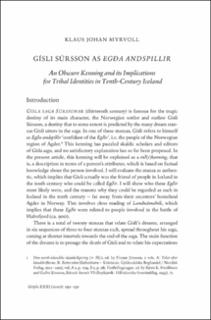| dc.contributor.author | Myrvoll, Klaus Johan | |
| dc.date.accessioned | 2021-02-09T11:48:47Z | |
| dc.date.available | 2021-02-09T11:48:47Z | |
| dc.date.created | 2021-01-06T11:49:47Z | |
| dc.date.issued | 2020-12 | |
| dc.identifier.citation | Myrvoll, K.J. (2020) Gísli Súrsson as Egða andspillir. An Obscure Kenning and its Implications for Tribal Identities in Tenth-Century Iceland. Gripla, 31, 199-232. | en_US |
| dc.identifier.issn | 1018-5011 | |
| dc.identifier.uri | https://hdl.handle.net/11250/2726884 | |
| dc.description.abstract | Gísla saga súrssonar (thirteenth century) is famous for the tragic destiny of its main character, the Norwegian settler and outlaw Gísli Súrsson, a destiny that to some extent is predicted by the many dream stanzas Gísli utters in the saga. In one of these stanzas, Gísli refers to himself as Egða andspillir ‘confidant of the Egðir’, i.e. the people of the Norwegian region of Agder. This kenning has puzzled skaldic scholars and editors of Gísla saga, and no satisfactory explanation has so far been proposed. In the present article, this kenning is explained as a við(r)kenning, that is, a description in terms of a person’s attributes, which is based on factual knowledge about the person involved. I evaluate the stanza as authentic, and so implying that Gísli actually was the friend of people in Iceland in the tenth century who could be called Egðir. I show that these Egðir most likely were members of the family of Ingjaldr in Hergilsey, who according to the saga hid Gísli from his enemies for three years, and whom Gísli mentions in one of his other stanzas. Landnámabók tells us that Ingjaldr’s paternal grandfather came to Iceland from Agder together with the chieftain Geirmundr heljarskinn, and that Geirmundr and his men had to flee from Norway because of the new centralized rule of Haraldr hárfagri. The story about Haraldr’s ofríki (‘harsh rule’) is probably exaggerated in the Icelandic tradition, but there is support in the sources for the hypothesis that a retinue of men who lost against Haraldr in the battle of Hafrsfjord (ca. 900) left Agder for Iceland. The fact that Ingjaldr and his family could be considered Egðir two generations and more than sixty years after they had left Agder calls for an explanation. This article argues that the special background of these families in a lost kingdom of Agder may have contributed to strengthening their identity as a special group of people in the recently populated Iceland. | en_US |
| dc.language.iso | eng | en_US |
| dc.publisher | Árni Magnússon Institute for Icelandic Studies | en_US |
| dc.rights | Navngivelse-Ikkekommersiell-DelPåSammeVilkår 4.0 Internasjonal | * |
| dc.rights.uri | http://creativecommons.org/licenses/by-nc-sa/4.0/deed.no | * |
| dc.subject | norrøn litteratur | en_US |
| dc.subject | skaldediktning | en_US |
| dc.subject | Gísla saga Súrssonar | en_US |
| dc.subject | slaget ved Harfsfjord | en_US |
| dc.subject | befolkningen av Island | en_US |
| dc.title | Gísli Súrsson as Egða andspillir. An Obscure Kenning and its Implications for Tribal Identities in Tenth-Century Iceland | en_US |
| dc.type | Peer reviewed | en_US |
| dc.type | Journal article | en_US |
| dc.description.version | publishedVersion | en_US |
| dc.rights.holder | (c) 2020 Klaus Johan Myrvoll | en_US |
| dc.subject.nsi | VDP::Humaniora: 000::Litteraturvitenskapelige fag: 040::Nordisk litteratur: 042 | en_US |
| dc.source.pagenumber | 199-232 | en_US |
| dc.source.volume | 31 | en_US |
| dc.source.journal | Gripla | en_US |
| dc.identifier.doi | 10.33112/gripla.31 | |
| dc.identifier.cristin | 1866215 | |
| cristin.ispublished | true | |
| cristin.fulltext | original | |
| cristin.fulltext | original | |
| cristin.qualitycode | 1 | |

